Cluster-ID-Based Throughput Improvement in Cognitive Radio Networks for 5G and Beyond-5G IoT Applications
Abstract
:1. Introduction
- Methods of increasing the throughput of SUs.
- A discussion of the spectrum utilization problem.
- The proposal of cluster-based cooperative spectrum sensing (CBCSS) to perform cooperative spectrum sensing in 5G and beyond-5G IoT applications.
2. Literature Survey
3. Cluster-Based Cooperative Spectrum Sensing (CBCSS)
System Model
4. Results and Discussion
Simulation Parameters
| Algorithm1: Greedy algorithm |
| Input: |
| (,),. |
| Initialization: = , = Ø, , l 1, = [1] and = [0] |
| = arg deg(y) |
| while || ≥ and || 0 |
| = arg |
| ;[] = ,); |
| = 1; |
| = 0; i ; update ; |
| end if |
| Find l*=arg []; |
| ;, ……………………}. |
| return rules |
5. Conclusions
Author Contributions
Funding
Conflicts of Interest
References
- Quan, Z.; Cui, S.; Sayed, A.H. Optimal linear cooperation for spectrum sensing in cognitive radio networks. IEEE J. Sel. Signal Process. 2008, 2, 28–40. [Google Scholar] [CrossRef]
- Niyato, D.; Hossain, E. Spectrum trading in cognitive radio networks: A market equilibrium based approach. IEEE Wirel. Commun. 2008, 15, 71–80. [Google Scholar] [CrossRef]
- Nasif, A.O.; Mark, B.L. Opportunistic spectrum sharing with multiple cochannel primary transmitters. IEEE Transact. Wirel. Commun. 2009, 8, 11. [Google Scholar] [CrossRef]
- Yue, G.; Wang, X. Anti-jamming coding techniques with application to cognitive radio. IEEE Transact. Wirel. Commun. 2009, 8, 12. [Google Scholar] [CrossRef]
- Devaraj, S.A.; Aruna, T.; Muthukumaran, N.; Roobert, A.A. Adaptive cluster-based heuristic approach in cognitive radio networks for 5G applications. Trans. Emerg. Tel. Tech. 2022, 33, e4383. [Google Scholar] [CrossRef]
- Rashid, M.M.; Hossain, J.; Hossain, E.; Bhargava, V.K. Opportunistic spectrum scheduling for multiuser cognitive radio: A queueing analysis. IEEE Transact. Wirel. Commun. 2009, 8, 5259–5269. [Google Scholar] [CrossRef]
- Song, C.; Zhang, Q. Cooperative spectrum sensing with multi-channel coordination in cognitive radio networks. In Proceedings of the IEEE International Conference on Communications, Cape Town, South Africa, 23–27 May 2010; p. 1. [Google Scholar]
- Wang, B.; Zhao, D.; Cai, J. Joint connection admission control and packet scheduling in a cognitive radio network with spectrum underlay. IEEE Transact. Wirel. Commun. 2011, 10, 3852–3863. [Google Scholar] [CrossRef]
- Nguyen, M.V.; Lee, H.S. Effective scheduling in infrastructure-based cognitive radio networks. IEEE Transact. Mobile Comput. 2011, 10, 853–867. [Google Scholar] [CrossRef]
- Azarfar, A.; Frigon, J.-F.; Sans‘o, B. Analysis of cognitive radio networks based on a queueing model with server interruptions. In Proceedings of the IEEE International Conference on Communications, ICC, Ottawa, ON, Canada, 10–5 June 2012; pp. 1703–1708. [Google Scholar]
- Li, X.; Li, W.; Hei, Y. Joint spectrum sensing and user selection strategy for cognitive radio networks. In Proceedings of the International Conference on Wireless Communications & Signal Processing (WCSP), Huangshan, China, 25–27 October 2012; pp. 1–6. [Google Scholar]
- Ruby, D.; Vijayalakshmi, M. Scheduling scheme with dynamic packet shifting in multichannel cognitive radio adhoc network. In Emerging Research in Computing, Information, Communication and Application; Elsevier Publications: Amsterdam, The Netherlands, 2013. [Google Scholar]
- Xue, D.; Ekici, E. Efficient distributed scheduling in cognitive radio networks in the many-channel regime. In Proceedings of the International Symposium and Workshops on Modeling and Optimization in Mobile, Ad Hoc and Wireless Networks, Tsukuba, Japan, 13–17 May 2013. [Google Scholar]
- Ji, C.; Nie, X.; Yuan, Y. A cross-layer scheduling algorithm based on cognitive radio network. Appl. Math. Inf. Sci. Int. J. 2013, 7, 611–617. [Google Scholar] [CrossRef]
- Yu, L.; Liu, C.; Zhu, W.; Hua, S.; Wang, W. Bandwidth efficient and rate-adaptive video delivery in TV white space. IEEE Transact. Circuits Syst. Video Technol. 2014, 24, 1605–1619. [Google Scholar] [CrossRef]
- Parzy, M.; Bogucka, H. Coopetition methodology for resource sharing in distributed OFDM-based cognitive radio networks. IEEE Transact. Commun. 2014, 62, 1518–1529. [Google Scholar] [CrossRef]
- Abbas, N.; Nasser, Y.; Ahmad, K.E. Recent advances on artificial intelligence and learning techniques in cognitive radio networks. EURASIP J. Wirel. Commun. Netw. 2015, 2015, 174. [Google Scholar] [CrossRef]
- Tsakmalis, A.; Chatzinotas, S.; Ottersten, B. Centralized power control in cognitive radio networks using modulation and coding classification feedback. arXiv 2015, preprint. arXiv:1510.06634. [Google Scholar] [CrossRef]
- Zhu, X.; Yang, B.; Chen, C.; Xue, L.; Guan, X.; Wu, F. Crosslayer scheduling for OFDMA-based cognitive radio systems with delay and security constraints. IEEE Transact. Veh. Technol. 2016, 64, 5919–5934. [Google Scholar] [CrossRef]
- Orumwense, E.F.; Afullo, J.T.; Srivastava, V.M. Achieving a better energy-efficient cognitive radio network. Int J. Comput. Inf. Syst. Ind. Manag. Appl. 2016, 8, 205–213. [Google Scholar]
- Alberti, A.M.; Mazzer, D.; Bontempo, M.M.; de Oliveira, L.H.; da Rosa Righi, R.; Sodré, A.C. Cognitive radio in the context of internet of things using a novel future internet architecture called Nova Genesis. Comput. Electr. Eng. 2018, 57, 147–161. [Google Scholar] [CrossRef]
- Heejung, Y.; Yousaf, B. Cognitive radio networks for internet of things and wireless sensor networks. Sensors 2020, 20, 5288. [Google Scholar] [CrossRef] [PubMed]
- Li, X.; Zhou, R.; Zhou, T.; Liu, L.; Yu, K. Connectivity probability analysis for green cooperative cognitive vehicular networks. IEEE Transact. Green Commun. Netw. 2022, 6, 1553–1563. [Google Scholar] [CrossRef]
- Sun, Y.; Yu, K.; Bashir Liao, X. Bl-IEA: A bit-level image encryption algorithm for cognitive services in intelligent transportation systems. IEEE Transact. Intell. Transp. Syst. 2021, 1–13. [Google Scholar] [CrossRef]
- Kottursamy, K.; Rehman Khan, A.; Sadayappillai, B.; Raja, G. Optimized D-RAN aware data retrieval for 5G information centric networks. Wirel. Pers. Commun. 2022, 124, 1011–1032. [Google Scholar] [CrossRef]
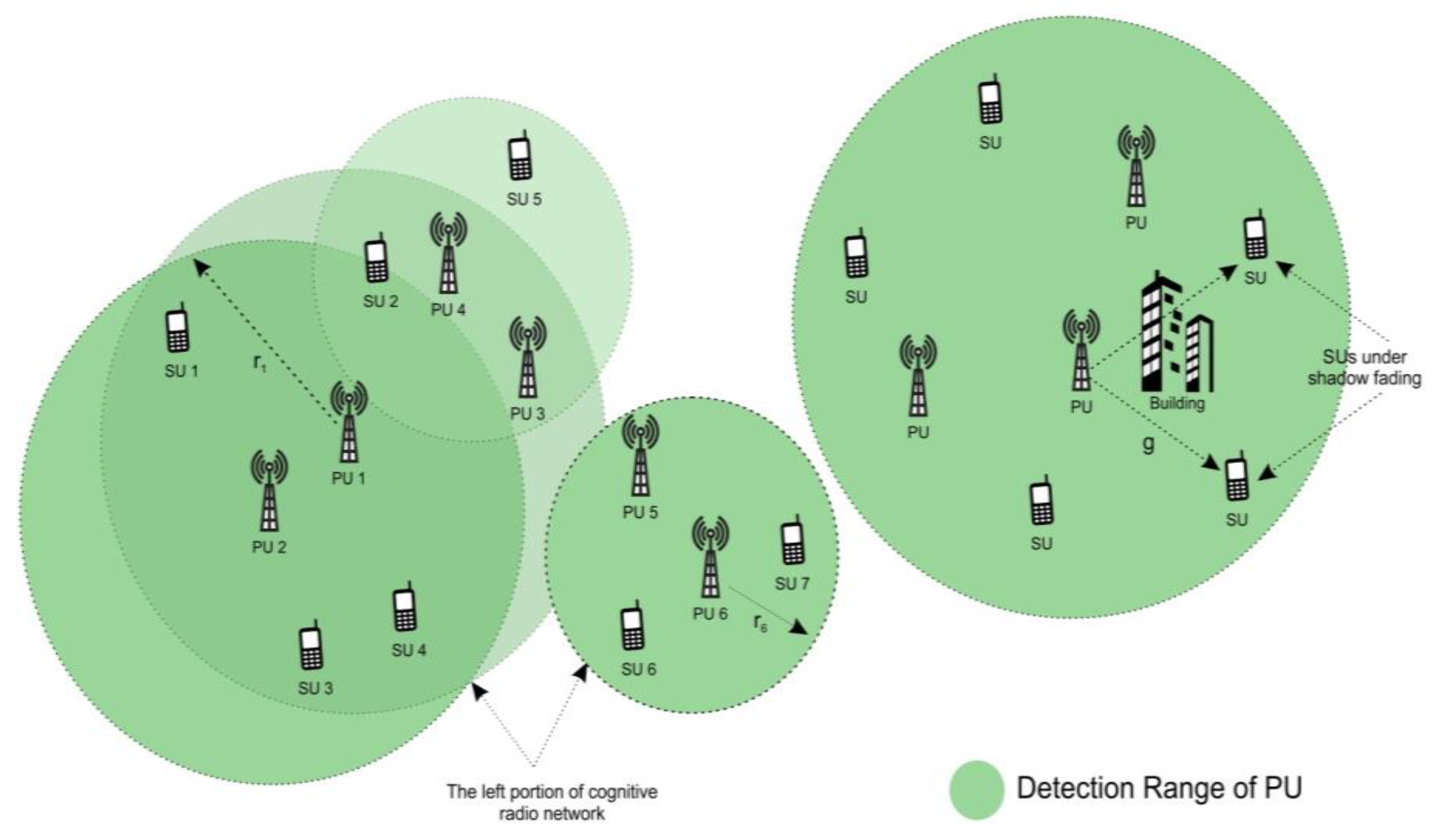

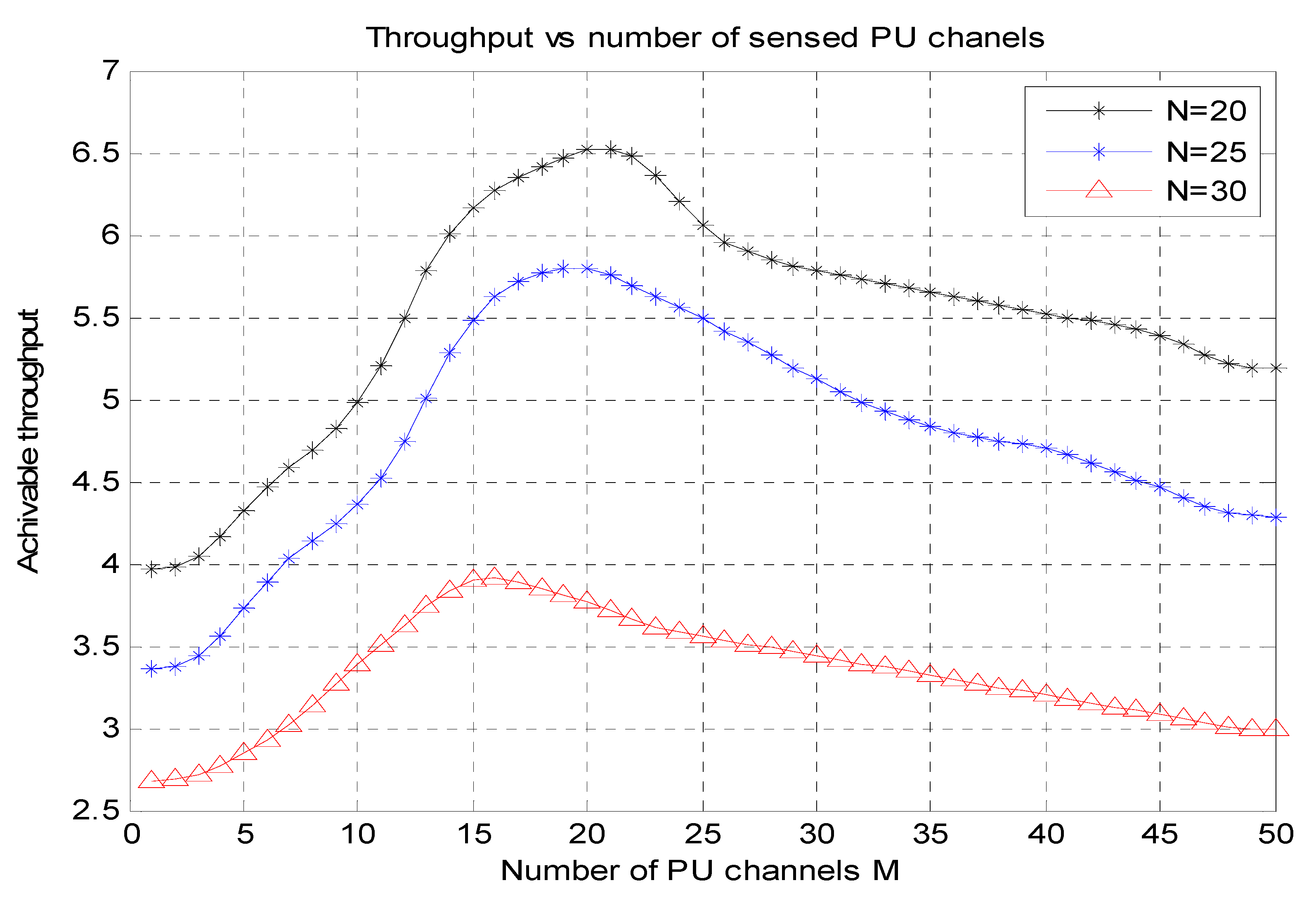
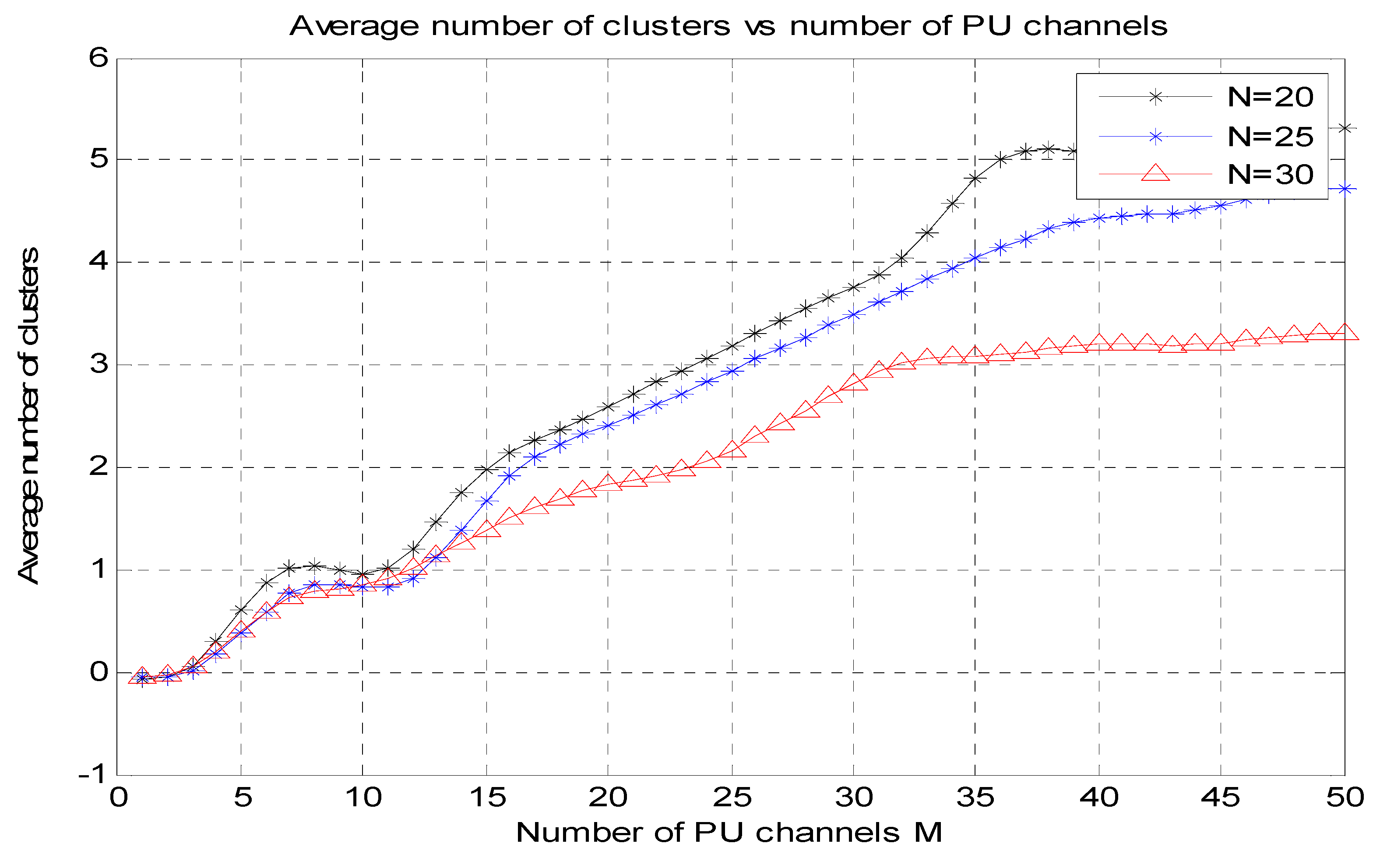
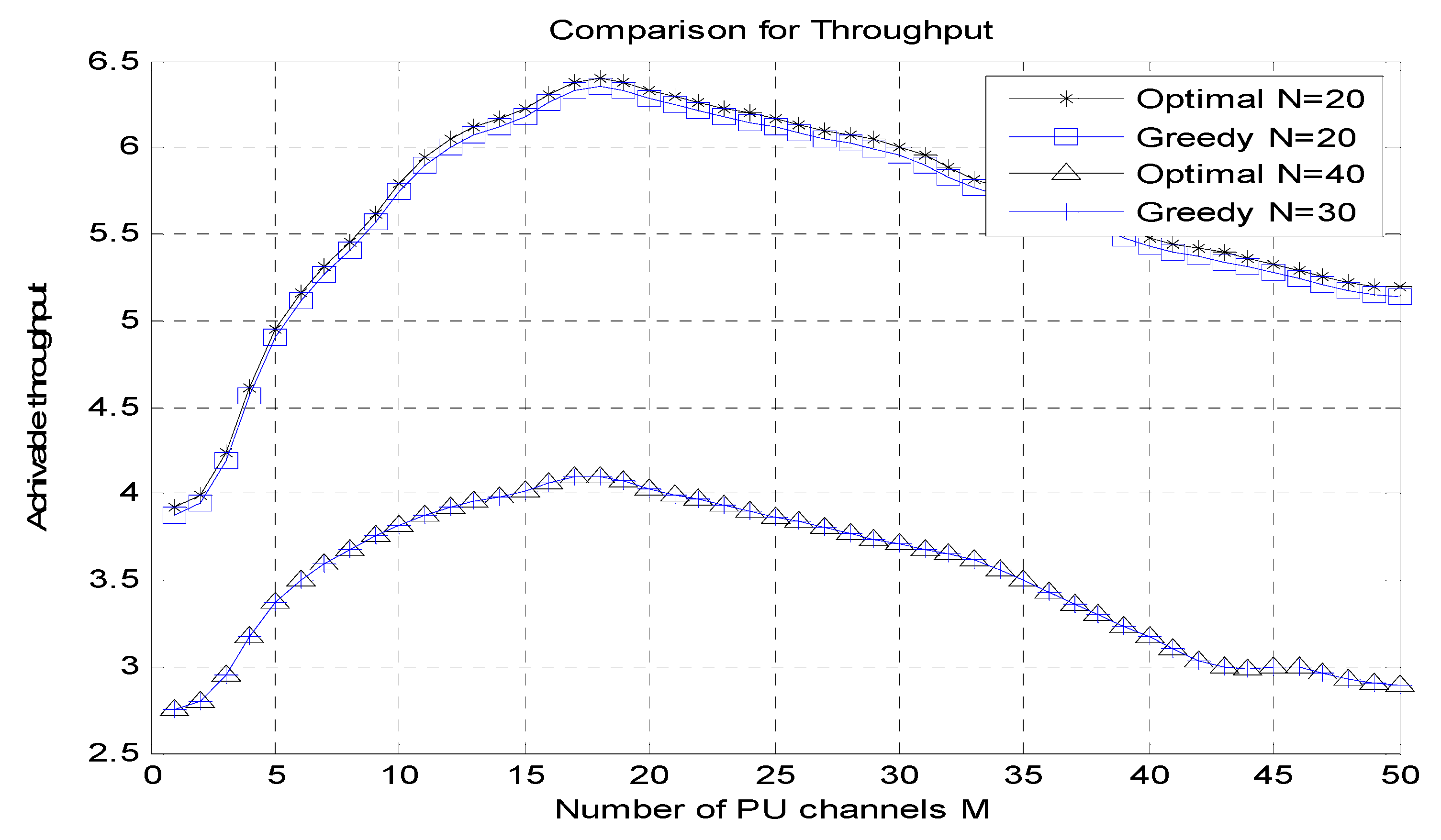
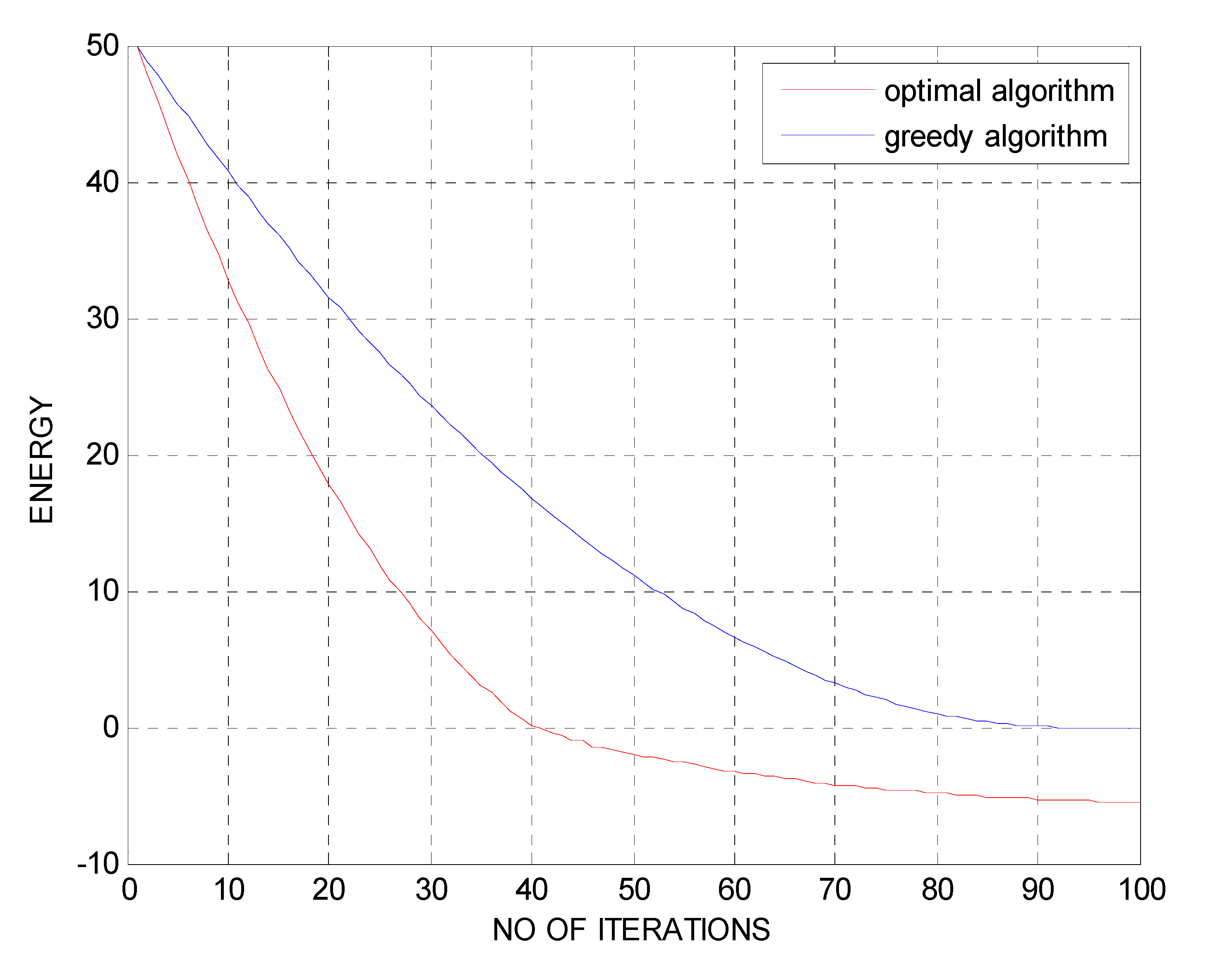
| Description | Range |
|---|---|
| Simulation Area | 1200 × 700 m |
| Primary Users (M) | 50 |
| Secondary Users (N) | 40 |
| Cluster Size | 25 users/cluster |
| Number of Clusters | 04 |
| Transmission Range | 250 m |
| Packet Size | 165 bytes |
| Mobility Model | Random Waypoint |
| Node Pause Time | 5 s |
| Sampling Frequency | 6 MHz |
| Sensing Time | 3–4 ms |
| Parameters | Song et al. [7] | Ruby et al. [12] | Li et al. [15] | Nadine et al. [17] | Proposed CBCSS |
|---|---|---|---|---|---|
| Achievable throughput | 92.73% | 84.83% | 90.24% | 82.90% | 96.87% |
| Average number of clusters | 2 | 1 | 3 | 3 | 5 |
| Energy | 1.87 bits/J | 3.64 bits/J | 0.94 bits/J | 6.23 bits/J | 0.23 bits/J |
Publisher’s Note: MDPI stays neutral with regard to jurisdictional claims in published maps and institutional affiliations. |
© 2022 by the authors. Licensee MDPI, Basel, Switzerland. This article is an open access article distributed under the terms and conditions of the Creative Commons Attribution (CC BY) license (https://creativecommons.org/licenses/by/4.0/).
Share and Cite
Devaraj, S.A.; Gurumoorthy, K.B.; Kumar, P.; Jacob, W.S.; Rosita, P.J.D.; Ali, T. Cluster-ID-Based Throughput Improvement in Cognitive Radio Networks for 5G and Beyond-5G IoT Applications. Micromachines 2022, 13, 1414. https://doi.org/10.3390/mi13091414
Devaraj SA, Gurumoorthy KB, Kumar P, Jacob WS, Rosita PJD, Ali T. Cluster-ID-Based Throughput Improvement in Cognitive Radio Networks for 5G and Beyond-5G IoT Applications. Micromachines. 2022; 13(9):1414. https://doi.org/10.3390/mi13091414
Chicago/Turabian StyleDevaraj, Stalin Allwin, Kambatty Bojan Gurumoorthy, Pradeep Kumar, Wilson Stalin Jacob, Prince Jenifer Darling Rosita, and Tanweer Ali. 2022. "Cluster-ID-Based Throughput Improvement in Cognitive Radio Networks for 5G and Beyond-5G IoT Applications" Micromachines 13, no. 9: 1414. https://doi.org/10.3390/mi13091414
APA StyleDevaraj, S. A., Gurumoorthy, K. B., Kumar, P., Jacob, W. S., Rosita, P. J. D., & Ali, T. (2022). Cluster-ID-Based Throughput Improvement in Cognitive Radio Networks for 5G and Beyond-5G IoT Applications. Micromachines, 13(9), 1414. https://doi.org/10.3390/mi13091414







